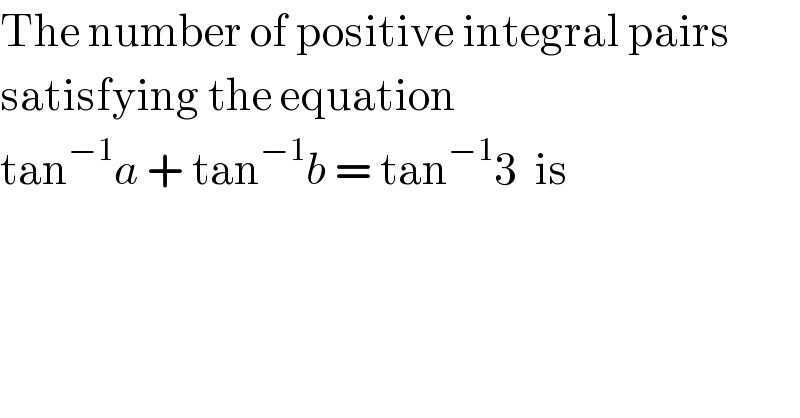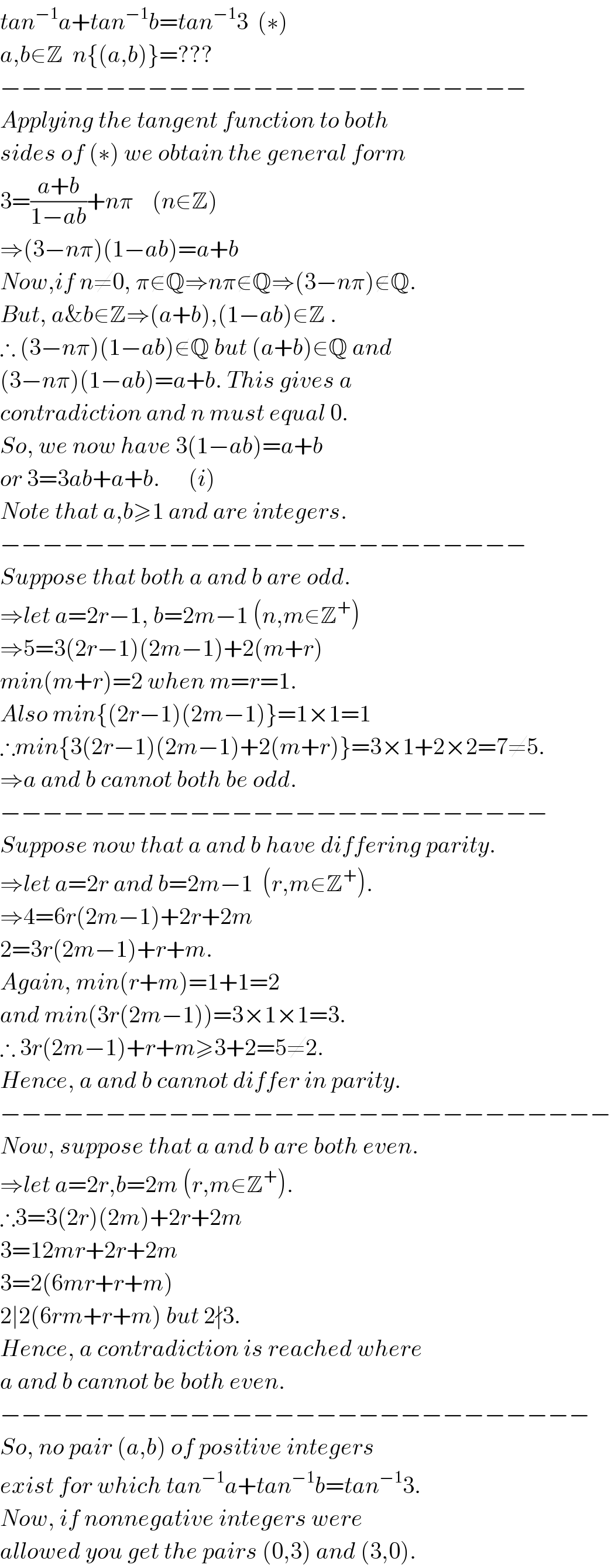Question Number 6043 by shaikreshma last updated on 10/Jun/16

$$\mathrm{The}\:\mathrm{number}\:\mathrm{of}\:\mathrm{positive}\:\mathrm{integral}\:\mathrm{pairs} \\ $$$$\mathrm{satisfying}\:\mathrm{the}\:\mathrm{equation} \\ $$$$\mathrm{tan}^{−\mathrm{1}} {a}\:+\:\mathrm{tan}^{−\mathrm{1}} {b}\:=\:\mathrm{tan}^{−\mathrm{1}} \mathrm{3}\:\:\mathrm{is} \\ $$
Answered by Yozzii last updated on 11/Jun/16

$${tan}^{−\mathrm{1}} {a}+{tan}^{−\mathrm{1}} {b}={tan}^{−\mathrm{1}} \mathrm{3}\:\:\left(\ast\right) \\ $$$${a},{b}\in\mathbb{Z}\:\:{n}\left\{\left({a},{b}\right)\right\}=??? \\ $$$$−−−−−−−−−−−−−−−−−−−−−−−−− \\ $$$${Applying}\:{the}\:{tangent}\:{function}\:{to}\:{both} \\ $$$${sides}\:{of}\:\left(\ast\right)\:{we}\:{obtain}\:{the}\:{general}\:{form} \\ $$$$\mathrm{3}=\frac{{a}+{b}}{\mathrm{1}−{ab}}+{n}\pi\:\:\:\:\left({n}\in\mathbb{Z}\right) \\ $$$$\Rightarrow\left(\mathrm{3}−{n}\pi\right)\left(\mathrm{1}−{ab}\right)={a}+{b} \\ $$$${Now},{if}\:{n}\neq\mathrm{0},\:\pi\notin\mathbb{Q}\Rightarrow{n}\pi\notin\mathbb{Q}\Rightarrow\left(\mathrm{3}−{n}\pi\right)\notin\mathbb{Q}. \\ $$$${But},\:{a\&b}\in\mathbb{Z}\Rightarrow\left({a}+{b}\right),\left(\mathrm{1}−{ab}\right)\in\mathbb{Z}\:. \\ $$$$\therefore\:\left(\mathrm{3}−{n}\pi\right)\left(\mathrm{1}−{ab}\right)\notin\mathbb{Q}\:{but}\:\left({a}+{b}\right)\in\mathbb{Q}\:{and} \\ $$$$\left(\mathrm{3}−{n}\pi\right)\left(\mathrm{1}−{ab}\right)={a}+{b}.\:{This}\:{gives}\:{a}\: \\ $$$${contradiction}\:{and}\:{n}\:{must}\:{equal}\:\mathrm{0}. \\ $$$${So},\:{we}\:{now}\:{have}\:\mathrm{3}\left(\mathrm{1}−{ab}\right)={a}+{b} \\ $$$${or}\:\mathrm{3}=\mathrm{3}{ab}+{a}+{b}.\:\:\:\:\:\:\left({i}\right) \\ $$$${Note}\:{that}\:{a},{b}\geqslant\mathrm{1}\:{and}\:{are}\:{integers}. \\ $$$$−−−−−−−−−−−−−−−−−−−−−−−−− \\ $$$${Suppose}\:{that}\:{both}\:{a}\:{and}\:{b}\:{are}\:{odd}. \\ $$$$\Rightarrow{let}\:{a}=\mathrm{2}{r}−\mathrm{1},\:{b}=\mathrm{2}{m}−\mathrm{1}\:\left({n},{m}\in\mathbb{Z}^{+} \right) \\ $$$$\Rightarrow\mathrm{5}=\mathrm{3}\left(\mathrm{2}{r}−\mathrm{1}\right)\left(\mathrm{2}{m}−\mathrm{1}\right)+\mathrm{2}\left({m}+{r}\right) \\ $$$${min}\left({m}+{r}\right)=\mathrm{2}\:{when}\:{m}={r}=\mathrm{1}. \\ $$$${Also}\:{min}\left\{\left(\mathrm{2}{r}−\mathrm{1}\right)\left(\mathrm{2}{m}−\mathrm{1}\right)\right\}=\mathrm{1}×\mathrm{1}=\mathrm{1} \\ $$$$\therefore{min}\left\{\mathrm{3}\left(\mathrm{2}{r}−\mathrm{1}\right)\left(\mathrm{2}{m}−\mathrm{1}\right)+\mathrm{2}\left({m}+{r}\right)\right\}=\mathrm{3}×\mathrm{1}+\mathrm{2}×\mathrm{2}=\mathrm{7}\neq\mathrm{5}. \\ $$$$\Rightarrow{a}\:{and}\:{b}\:{cannot}\:{both}\:{be}\:{odd}. \\ $$$$−−−−−−−−−−−−−−−−−−−−−−−−−− \\ $$$${Suppose}\:{now}\:{that}\:{a}\:{and}\:{b}\:{have}\:{differing}\:{parity}. \\ $$$$\Rightarrow{let}\:{a}=\mathrm{2}{r}\:{and}\:{b}=\mathrm{2}{m}−\mathrm{1}\:\:\left({r},{m}\in\mathbb{Z}^{+} \right). \\ $$$$\Rightarrow\mathrm{4}=\mathrm{6}{r}\left(\mathrm{2}{m}−\mathrm{1}\right)+\mathrm{2}{r}+\mathrm{2}{m} \\ $$$$\mathrm{2}=\mathrm{3}{r}\left(\mathrm{2}{m}−\mathrm{1}\right)+{r}+{m}. \\ $$$${Again},\:{min}\left({r}+{m}\right)=\mathrm{1}+\mathrm{1}=\mathrm{2}\: \\ $$$${and}\:{min}\left(\mathrm{3}{r}\left(\mathrm{2}{m}−\mathrm{1}\right)\right)=\mathrm{3}×\mathrm{1}×\mathrm{1}=\mathrm{3}. \\ $$$$\therefore\:\mathrm{3}{r}\left(\mathrm{2}{m}−\mathrm{1}\right)+{r}+{m}\geqslant\mathrm{3}+\mathrm{2}=\mathrm{5}\neq\mathrm{2}. \\ $$$${Hence},\:{a}\:{and}\:{b}\:{cannot}\:{differ}\:{in}\:{parity}. \\ $$$$−−−−−−−−−−−−−−−−−−−−−−−−−−−−− \\ $$$${Now},\:{suppose}\:{that}\:{a}\:{and}\:{b}\:{are}\:{both}\:{even}. \\ $$$$\Rightarrow{let}\:{a}=\mathrm{2}{r},{b}=\mathrm{2}{m}\:\left({r},{m}\in\mathbb{Z}^{+} \right). \\ $$$$\therefore\mathrm{3}=\mathrm{3}\left(\mathrm{2}{r}\right)\left(\mathrm{2}{m}\right)+\mathrm{2}{r}+\mathrm{2}{m} \\ $$$$\mathrm{3}=\mathrm{12}{mr}+\mathrm{2}{r}+\mathrm{2}{m} \\ $$$$\mathrm{3}=\mathrm{2}\left(\mathrm{6}{mr}+{r}+{m}\right) \\ $$$$\mathrm{2}\mid\mathrm{2}\left(\mathrm{6}{rm}+{r}+{m}\right)\:{but}\:\mathrm{2}\nmid\mathrm{3}. \\ $$$${Hence},\:{a}\:{contradiction}\:{is}\:{reached}\:{where} \\ $$$${a}\:{and}\:{b}\:{cannot}\:{be}\:{both}\:{even}. \\ $$$$−−−−−−−−−−−−−−−−−−−−−−−−−−−− \\ $$$${So},\:{no}\:{pair}\:\left({a},{b}\right)\:{of}\:{positive}\:{integers} \\ $$$${exist}\:{for}\:{which}\:{tan}^{−\mathrm{1}} {a}+{tan}^{−\mathrm{1}} {b}={tan}^{−\mathrm{1}} \mathrm{3}. \\ $$$${Now},\:{if}\:{nonnegative}\:{integers}\:{were} \\ $$$${allowed}\:{you}\:{get}\:{the}\:{pairs}\:\left(\mathrm{0},\mathrm{3}\right)\:{and}\:\left(\mathrm{3},\mathrm{0}\right). \\ $$
Commented by Rasheed Soomro last updated on 12/Jun/16

$$\mathfrak{NICE}! \\ $$
